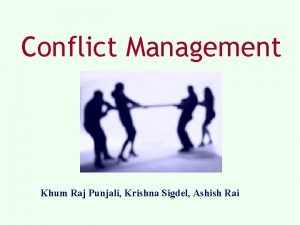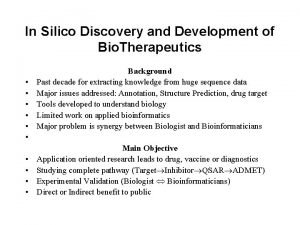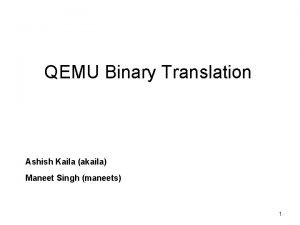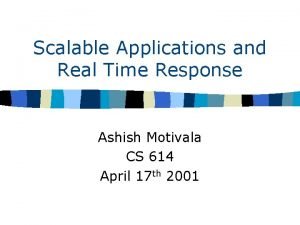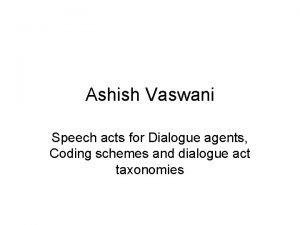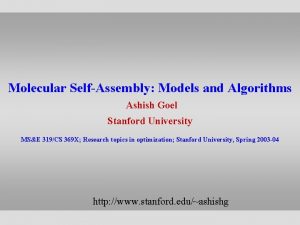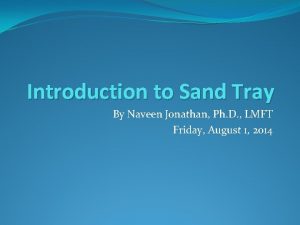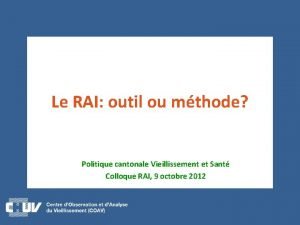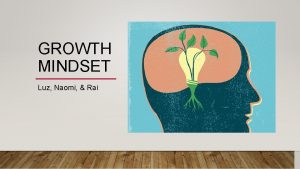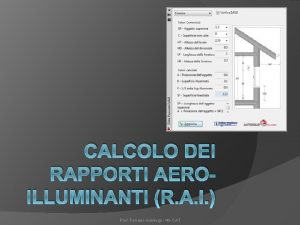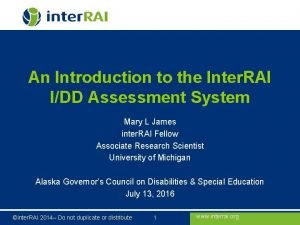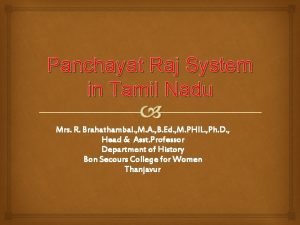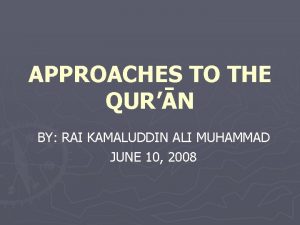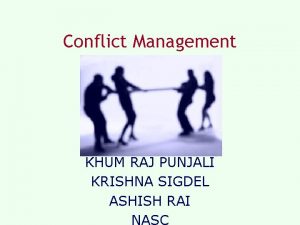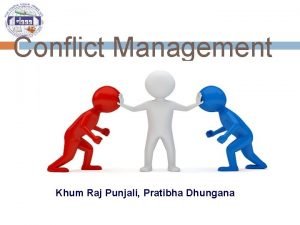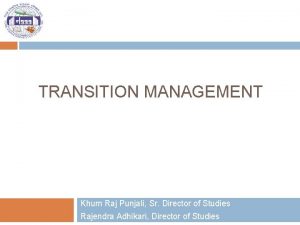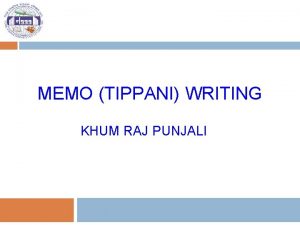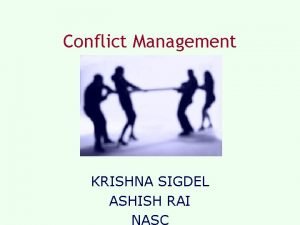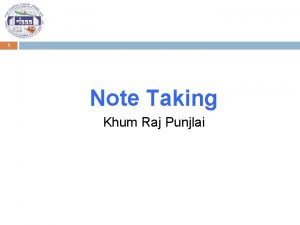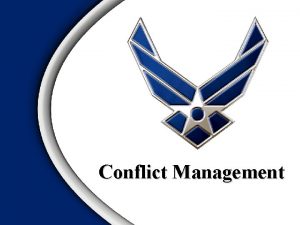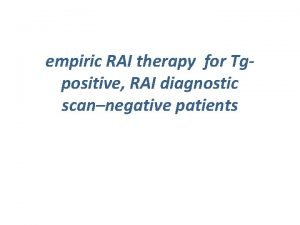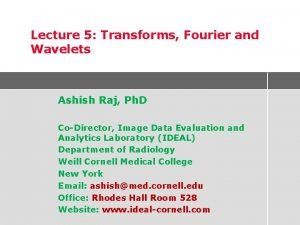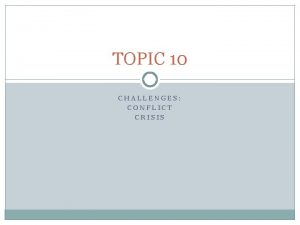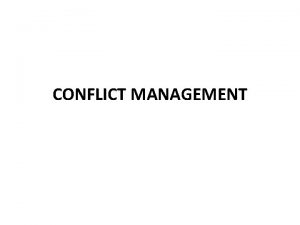Conflict Management Khum Raj Punjali Ashish Rai Definition
































- Slides: 32

Conflict Management Khum Raj Punjali / Ashish Rai

Definition of conflict • Negative ? ? ? • Harmful ? ? ?

Session Coverage • Understanding conflict • Conflicting Situations • Conflict Management: What? Why and, How? • Conclusion


Forethought • A good manager does not want to eliminate conflict. He tries to keep it from wasting the energies of his people. If you are the boss and your people fight openly when they think that you are wrong- that’s healthy. - Robert Townsend

True or False 1. Conflict left alone will take care of itself. 2. Confronting an issue or a person is always unpleasant. 3. Conflict within an organization is a sign of poor leadership. 4. It takes two people communicating effectively to change the direction of a conflict. Contd…

True or False 5. Conflict can be constructive. 6. How we respond to others and situations is based on the attitude we take. 7. Anger is always negative and destructive. 8. Communication is 50% verbal and 50% nonverbal.

True or False 9. Conflict is resolved once the goal switches from solving concrete problems to proving you are right and another person is wrong. 10. Communication and emotion are two key elements of any conflict. 11. Conflict is best dealt with in the early stages when the fewest number of people are involved. 12. In times of conflict it is important to speak loudly and with authority in order to make a point.

Data says… • It is estimated that 30% of a manager’s time is spent dealing with conflict • Corporate executives are involved in litigation related activity 20% of their time. • Conflicts contributes most adversely to organizational productivity. - HBR, September 1994

Four Basic Psychological Needs: • To be valued and treated as an individual • To be in control • To have strong selfesteem • To be consistent

Views on Conflict TRADITIONAL seen as dysfunctional outcome resulting from poor communication, lack of openness & trust between people, failure of managers to be responsive to needs & aspirations of employees.

Views on Conflict Contd…. HUMANISTIC Seen as natural & inevitable outcome in any group.

Views on Conflict Contd…. INTERACTIONISTIC a positive force that is necessary for a group effectiveness, self critical & creative.

PROCESS in which Perception of one party being negatively affected… On an issue of importance to the perceiver

CONFLICT PROCESS FIVE STAGES I. POTENTIAL OPPOSITION OR INCOMPATIBILITY II. COGNITION & PERSONALIZATION III. INTENTION IV. BEHAVIOR V. OUTCOMES

STAGE I: POTENTIAL OPPOSITION/INCOMPATIBILITY Conditions – Ambiguous Communication. – Structure in terms of size, degree of specialization, role clarity & centralization of authority, degree of dependence between groups. – Personal variables. {This stage indicates presence of conditions that create opportunities for conflict to arise. }

Stage II: PERCEPTION & AWARENESS • PERCEIVED CONFLICT awareness by one or more parties of the existence of conditions that create opportunities for conflict to arise. Not personalized. • FELT CONFLICT getting emotionally involved in a conflict creating anxiety, frustration or hostility. {This is the stage where conflict issues get defined & parties decide what the conflict is all about. It also brings forth the emotional linkages to the issue. }

Thomas, K. W. & Kilman, R. H. Thomas-Kilman Conflict Mode Instrument

Stage III: INTENTIONS Conflict Handling Intentions – COMPETING: Desire to satisfy one’s interest regardless of impact of other party to the conflict. – COLLABORATING: Desire to satisfy fully concerns of all parties. – AVOIDING: Desire to withdraw or suppress a conflict. – ACCOMODATING: willingness to place opponent’s interests above own. – COMPROMISING: Willingness to give up something.

Assertiveness Competing Collaborating Compromising Avoiding Accommodating Cooperativeness

Stage IV: BEHAVIOUR • Minor Disagreement or misunderstanding • Overt questioning or challenging of others • Assertive verbal attacks • Threats & ultimatums • Aggressive physical attacks • Overt efforts to destroy the other party

Stage V: OUTCOMES • FUNCTIONAL OUTCOMES IMPROVES QUALITY OF DECISIONS, STIMULATES CREATIVITY & INNOVATION, ENCOURAGES INTEREST & CURIOSITY, OPEN COMMUNICATION, TRANSPARENCY, FOSTERS ENVIRONMENT OF SELF EVALUATION & CHANGE.

OUTCOMES Contd…. • DYSFUNCTIONAL OUTCOMES DISSOLVE COMMON TIES, DISCONTENT , DESTRUCTION OF GROUP.

CONFLICT MANAGEMENT RESOLUTION , PREVENTION AND STIMULATION TECHNIQUES TO USE OF ACHIEVE THE DESIRED LEVEL OF CONFLICT

Why Conflict Management? “An eye for an eye makes the whole world blind” - Mahatma Gandhi

CONFLICT RESOLUTION TECHNIQUES n. PROBLEM SOLVING n. EXPANSION OF RESOURCES n. AVOIDANCE n. SMOOTHING n. COMPROMISE n. AUTHORITATIVE COMMAND n. ALTERING THE HUMAN VARIABLE n. ALTERING THE STRUCTURAL VARIABLES n. Face to face open discussions n. Create win-win situations n. Withdraw or suppress n. Playing down differences n. Giving up something of value n. Using formal authority n. Training for attitudinal change n. Changing formal structure& interaction patterns

WHEN TO USE DIFFERENT CONFLICT RESOLUTION APPROACHES APPROACH DOMINATING ACCOMMODATING PROBLEM SOLVING WHEN IMPORTANT ISSUES, SURE OF BEING RIGHT. DISPUTES THAT ARE OF FAR GREATER IMPORTANCE TO THE OTHER GROUP THAN THEY ARE TO YOUR GROUP. WHEN BOTH GROUPS ARE WILLING TO INVEST TIME & EFFORT TO REACH A RESOLUTION THAT MAXIMIES OUTCOME AVOIDING TEMPORARY EXPEDIENT TO BUY MORE TIME COMPROMISING MIDDLE GROUND –BACK UP APPROACH WHEN ALL APPROACHES FAIL TO RESOLVE ISSUE

Conflict Prevention Techniques • Super ordinate goals • Reducing interdependence • Exchange of personnel • Liaison group or integrators • Appeal to higher authority.

CONFLICT STIMULATION TECHNIQUES n. COMMUNICATION IN OUTSIDERS ambiguous or threatening messages n. With values conflicting with group n. RESTRUCTURING n. Realigning n. BRINGING ORGANIZATION n. APPOINTING ADVOCATE DEVIL’S n. Using work groups, altering rules , interdependence n. Designating a critic to argue against majority positions

VIDEO:

To sum up • Conflict is inevitable phenomenon • Human and non human factors are responsible for conflict • Functional conflict positively contribute to performance • Conflict handling intentions and conflict resolution/stimulation techniques need to be used appropriately

Thanks and Good day KRP/AR/2018
 Krishna sigdel
Krishna sigdel Ghadeer khum
Ghadeer khum Thomas khum
Thomas khum Ashish ganguly imtech
Ashish ganguly imtech Cseo microsoft
Cseo microsoft Ashish kachru
Ashish kachru Vmware binary translation
Vmware binary translation Ashish chogle
Ashish chogle Ashish motivala
Ashish motivala Ashish singh parihar
Ashish singh parihar Ashish bajaj fms
Ashish bajaj fms Dr ashish kumar bhutani
Dr ashish kumar bhutani Ashish vaswani
Ashish vaswani Ashish tilethe
Ashish tilethe Naveen ashish
Naveen ashish Ashish goel stanford
Ashish goel stanford External conflict
External conflict Indian rebellion of 1857 ap world
Indian rebellion of 1857 ap world Whats an external conflict
Whats an external conflict What is conflict and conflict resolution?
What is conflict and conflict resolution? Lady rai
Lady rai Rai oyau
Rai oyau Naomi rai
Naomi rai Rai cereal
Rai cereal Deepcluster
Deepcluster Tabella calcolo rai
Tabella calcolo rai Inter rai
Inter rai Aishwarya weight loss
Aishwarya weight loss Arka rai choudhuri
Arka rai choudhuri Piattaforma acquisti rai
Piattaforma acquisti rai G v k rao committee
G v k rao committee Haagen daz slogan
Haagen daz slogan Rai kamaluddin
Rai kamaluddin
